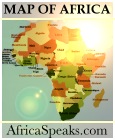An Ancient Link to Africa Lives on in Bay of Bengal
Posted: Tuesday, December 24, 2002Author: Nicholas Wade
Filed: 12/11/2002
Source: The New York Times
http://www.nytimes.com/2002/12/10/science/10ISLA.html
Inhabitants of the Andaman Islands, a remote archipelago east of India, are direct descendants of the first modern humans to have inhabited Asia, geneticists conclude in a new study.
But the islanders lack a distinctive genetic feature found among Australian aborigines, another early group to leave Africa, suggesting they were part of a separate exodus.
The Andaman Islanders are "arguably the most enigmatic people on our planet," a team of geneticists led by Dr. Erika Hagelberg of the University of Oslo write in the journal Current Biology.
Their physical features — short stature, dark skin, peppercorn hair and large buttocks — are characteristic of African Pygmies. "They look like they belong in Africa, but here they are sitting in this island chain in the middle of the Indian Ocean," said Dr. Peter Underhill of Stanford University, a co-author of the new report.
Adding to the puzzle is that their language, according to Joseph Greenberg, who, before his death in 2001, classified the world's languages, belongs to a family that includes those of Tasmania, Papua New Guinea and Melanesia.
Dr. Hagelberg has undertaken the first genetic analysis of the Andamanese with the help of two Indian colleagues who took blood samples — the islands belong to India — and by analyzing hair gathered almost a century ago by a British anthropologist, Alfred Radcliffe-Brown. The islands were isolated from the outside world until the British set up a penal colony there after the Indian mutiny of 1857.
Only four of the dozen tribes that once inhabited the island survive, with a total population of about 500 people. These include the Jarawa, who still live in the forest, and the Onge, who have been settled by the Indian government.
Genetic analysis of mitochondrial DNA, a genetic element passed down only through women, shows that the Onge and Jarawa people belong to a lineage, known as M, that is common throughout Asia, the geneticists say. This establishes them as Asians, not Africans, among whom a different mitochondrial lineage, called L, is dominant.
The geneticists then looked at the Y chromosome, which is passed down only through men and often gives a more detailed picture of genetic history than the mitochondrial DNA. The Onge and Jarawa men turned out to carry a special change or mutation in the DNA of their Y chromosome that is thought to be indicative of the Paleolithic population of Asia, the hunters and gatherers who preceded the first human settlements.
The mutation, known as Marker 174, occurs among ethnic groups at the periphery of Asia who avoided being swamped by the populations that spread after the agricultural revolution that occurred about 8,000 years ago. It is found in many Japanese, in the Tibetans of the Himalayas and among isolated people of Southeast Asia, like the Hmong.
The discovery of Marker 174 among the Andamanese suggests that they too are part of this relict Paleolithic population, descended from the first modern humans to leave Africa.
Dr. Underhill, an expert on the genetic history of the Y chromosome, said the Paleolithic population of Asia might well have looked as African as the Onge and Jarawa do now, and that people with the appearance of present-day Asians might have emerged only later. It is also possible, he said, that their resemblance to African Pygmies is a human adaptation to living in forests that the two populations developed independently.
A finding of particular interest is that the Andamanese do not carry another Y chromosome signature, known as Marker RPS4Y, that is common among Australian aborigines.
This suggests that there were at least two separate emigrations of modern humans from Africa, Dr. Underhill said. Both probably left northeast Africa by boat 40,000 or 50,000 years ago and pushed slowly along the coastlines of the Arabian Peninsula and India. No archaeological record of these epic journeys has been found, perhaps because the world's oceans were 120 meters lower during the last ice age and the evidence of early human passage is under water.
One group of emigrants that acquired the Marker 174 mutation reached Southeast Asia, including the Andaman islands, and then moved inland and north to Japan, in Dr. Underhill's reconstruction. A second group, carrying the Marker RPS4Y, took a different fork in Southeast Asia, continuing south toward Australia.Printer friendly version
Send page by E-Mail

Previous Page | Zimbabwe Watch | Historical Views | Home
NOTICE: All articles are the copyright property of the writers. In accordance with Title 17 U.S.C., section 107, some material on this site is provided without permission from the copyright owner, only for purposes of criticism, comment, scholarship and research under the "fair use" provisions of federal copyright laws. Visit: http://www.law.cornell.edu/uscode/17/107.shtml for more details. If you wish to use copyrighted material from this site for purposes of your own that go beyond 'fair use', you must obtain permission from the copyright owner.










